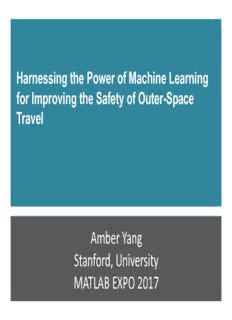
Amber Yang Stanford, University MATLAB EXPO 2017 PDF
Preview Amber Yang Stanford, University MATLAB EXPO 2017
Harnessing the Power of Machine Learning for Improving the Safety of Outer-Space Travel Amber Yang Stanford, University MATLAB EXPO 2017 What is Machine Learning? Arthur Samuel (1959). Machine Learning: Field of study that gives computers the ability to learn without being explicitly programmed. • Artificial Neural Networks (ANNs): computing systems based on connectionism. Artificial Neural Networks for Classifying and Tracking Space Debris Dangers of Space Debris in Low Earth Orbit Millions of space debris in Low Earth Orbit (LEO) pose collision threats to on-orbit spacecraft and satellites1 Kessler syndrome predicts space debris population will increase exponentially—challenging ability to track and catalogue collision threats2 1. B.G. Cour‐Palais et. al. 1978 Photo Source: European Space Agency 2. D.J. Kessler et. al. 2010 Traditional Orbital Tracking Methods Demonstration of Extended Kalman Filter; Photo Source: D.A. Vallado et. al. 1998 Utilization of radar, laser, and optical imagery to identify and observe space debris Extended Kalman Filter (EKF): state transition model of error dynamics statistically corrected via error covariance propagation to estimate orbital waypoints for trajectory prediction3 3. R.E. Kalman, 1960 Problem Space surveillance network requires detecting, tracking, and cataloguing algorithms all in one comprehensive system Space debris is small in size, travels at high speeds, and orbits at high altitudes These characteristics impact EKF tracking accuracy Astrodynamics of orbiting objects constantly changing due to celestial disturbances4 Frequent manual tuning of EKF parameters necessary for off- track space targets Without self-learning and training abilities, covariance- driven tracker must be adjusted for individual space targets 4. D.A. Vallado et. al. 1998 Orbital Patterns Recognized within Keplerian Elements Are there inherent geometrical patterns in the orbits of space debris that can be learned by an Artificial Neural Network for accurate detection and tracking over time? Phase One of Research: Orbital Recognition for Space Debris Tracking Using Artificial Neural Networks Theory and Hypothesis Theory: Study invoked by 2014 z E Nobel Prize for discovery that the brain can act as an inner- x Global Positioning System O (GPS) due to its ability to y o Debris Perigee recognize geometric patterns5 v r Hypothesis: If discovery of an inner-brain GPS is applied for an e y outer-space GPS, pattern E O a O E i recognition Artificial Neural O a: Semi‐Major Axis Networks (ANN)6 can act as a e: Eccentricity i: Inclination of Orbit Ascending human brain to detect, track, Equator : Argument of Perigee Node Plane (E) : Right Ascension of and catalogue orbits of space Ascending Node Orbital =rxv: Angular Momentum x Plane (O) : True Anomaly debris in LEO using Keplerian E Apogee elements that have inherent geometric patterns Geometrical Diagram of Keplerian Elements in Orbit 5. O’Keefe et. al. 1978
Description: